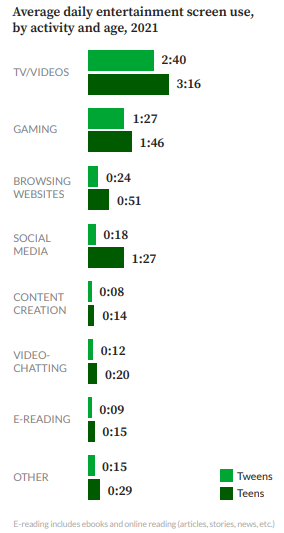Powerful Tools for Proactive Digital Parenting
Television has always had the power to draw children in. But now, technological advances have created even more attractive screen-based entertainment options. Smartphones and tablets have also come down in price, so they are now more widely available, and gaming storylines and graphics are more immersive than ever before. Virtual reality allows users to leave their reality and enter a digital world that many kids don’t want to exit.
When it comes to gaming consoles, while Microsoft doesn’t disclose the number of Xbox gaming consoles sold, industry experts estimate that total Xbox X/S series sales topped 10.3 million by the end of 2021. Another nine million are expected to land in consumers’ homes throughout 2022. Meanwhile, the PlayStation 5 sold more than 17 million units by the end of 2021, and sales are expected to total 18 million in 2022. The Nintendo Switch may do even better, with as many as 21 million units sold by the end of this year.
What does all this mean for families who want to balance gaming and other screen-related activities with off-screen life?
Smart Digital Parenting Doesn’t Mean a Total Screen Ban
There is nothing wrong with gaming, whether it takes place on a smartphone, a tablet, a computer, or a gaming console. In fact, research shows there are benefits to some screen-based activities. However, as with anything, moderation is key. Screen time becomes problematic when it takes the place of family time, friendships, schoolwork, and learning, and simply being outside participating in physical activities.
Parents have become keenly aware of the need for screen time management in the past several years, but the growth of the number of connected devices within families has made the need even more challenging…and more necessary. Children across all age groups have grown more accustomed to relying on screens over the past two years than ever before.

One survey found that daily screen use for children ages 8 to 18 increased 17 percent from 2019 to 2021. The average for tweens (8 to 12-year-olds) is now over five hours per day. The average for teens (13 to 18-year-olds) is now over eight hours per day. Screen time includes everything from passively tv watching to intense interactive gaming and everything in between.
Setting limits for your family can be challenging, but the good news is that there are effective and easily available parental control solutions to simplify this process. Whether the goal is to balance screen time with other activities, improve digital safety, or both, there are tools which can reduce the conflict parents and children experience concerning screen time management.
Simplify Digital Safety with Comprehensive Parental Controls
When looking for a solution to address these very real challenges, it’s important to look at a wide range of features. Parental controls aren’t just about controlling how much screen time is being used. Comprehensive parental controls are about managing all areas of device usage and behavior to keep your family safe and simplify parenting in our new digital age. They become a supportive component of, and partner in, your digital parenting strategy.
In fact, today’s families have multiple connected devices, and not just the ones used outside the home. So, it’s important to look at solutions that provide the same level of protection whether you’re at home or on the go.
Making Space for Screen-Free Time
It goes without saying that experts agree about the importance of having screen-free time. Pre-setting specific times of the day where the devices are turned off is important for a healthy, balanced lifestyle. But enforcing these limits can be challenging to say the least. Solutions that help manage screen time proactively, whether that means restricting specific apps or shutting devices down altogether, are a simple yet effective way to free up time for other fun activities with friends and family. There is no longer a need to nag your kids about putting away or turning off their devices; parental controls do that for you.
Positive Digital Parenting
Parenting experts regularly emphasize the importance of positive reinforcement, but it can be difficult to maintain a positive parenting style when screens are involved. Using a digital rewards feature can be used as positive reinforcement. For example, when children are displaying desired behaviors, you can reward them by giving them more screen time to use.
Suspend Internet Access
Getting children’s full attention when they are using their devices is often next to impossible. That leads to frustration and conflict that parents want to avoid. A fitting solution is the ability to suspend internet access at the press of a button. Whether parents wish to suspend access for the entire household, a single device, or a single person, it’s a simple alternative to dragging kids away from their screens. Families get family time and their kids back for these moments.
Internet Safety – The Issue That Keeps Parents Up at Night
The biggest concern for most parents is the safety of their children as they navigate the black hole that is the Internet. It’s far too easy for an innocent search to bring up explicit, violent, or otherwise inappropriate results. Find a solution that includes a “safe search” function, which can dramatically reduce the risk of accidental exposure to undesirable content, making the internet safer for your children and giving you peace of mind.
Single App Blocking
Families have different philosophies on what content is appropriate, and in some cases, that extends beyond just websites and apps. For example, some parents prefer that their children stay away from social media while others object to specific games or types of games. Solutions that allow for individual app blocking can provide another level of customization so parents can be confident their kids are having a positive digital experience.
Digital Safety Detectives
Robust parental controls give you the confidence to give your kids more freedom to explore the digital landscape. However, it is useful for parents to gain understanding of how screens are being used within the household. A comprehensive parental control solution should also include history and usage features that give parents visibility into their children’s online activities across all their devices. This can then enable parents to make better decisions that satisfy both the need for both safety and freedom to explore.
With SafePath Home, Smith Micro provides wireless carriers with a proven, white-label solution that simplifies digital parenting in the home. Used by the leading Tier 1 carriers in the U.S., the SafePath platform is the market leader in family safety, including location tracking, robust parental controls, driver safety features and more. Learn more at smithmicro.com/safepath and then contact us to request a demo.



